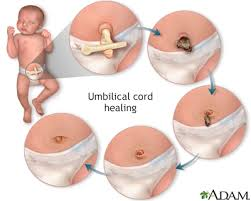A nurse is teaching a newborn's parent how to care for the umbilical cord stump. Which of the following instructions should the nurse include?
Apply petroleum jelly to the cord stump.
Give a sponge bath until the cord stump falls off.
Cover the cord with the diaper.
Wash the cord daily with mild soap and water.
The Correct Answer is B
Choice A reason:
Applying petroleum jelly to the umbilical cord stump is not recommended. The goal is to keep the stump dry to encourage the healing process. Petroleum jelly is a moisture barrier and could potentially keep the area too moist, which may delay the drying and falling off of the stump.
Choice B reason:
Giving sponge baths until the cord stump falls off is the correct practice. It is important to keep the stump dry, so sponge baths are preferred over tub baths during this time. This helps prevent the stump from staying wet, which can lead to infection or delayed healing.
Choice C reason:
It is not advised to cover the cord with the diaper. Instead, the diaper should be folded down away from the stump or use diapers with a special cut-out to keep the stump exposed to air. This helps the stump to dry and fall off more quickly.
Choice D reason:
Washing the cord daily with mild soap and water is not necessary and could be counterproductive. The stump should be kept dry, and if it gets dirty, it can be cleaned gently with a soft, damp cloth and then dried thoroughly. Regular bathing can introduce moisture, which may increase the risk of infection.

Nursing Test Bank
Naxlex Comprehensive Predictor Exams
Related Questions
Correct Answer is D
Explanation
Choice a reason:
An irregular fetal heart rate is not typically associated with a hydatidiform mole because, in many cases of complete molar pregnancy, there is no fetus, and thus no fetal heart rate to assess. In partial molar pregnancies, there may be a fetus with an irregular heart rate, but this is not a definitive sign of a hydatidiform mole.
Choice b reason:
Profuse, clear vaginal discharge is not a common finding in hydatidiform mole. The typical vaginal discharge associated with a molar pregnancy is often described as "grape-like" or "prune juice-like" due to the presence of molar tissue being passed.
Choice c reason:
A rapid decline in hCG levels is not expected in hydatidiform mole; in fact, unusually high levels of hCG are more characteristic of this condition. The abnormal placental tissue in a molar pregnancy tends to produce higher than normal amounts of hCG.
Choice d reason:
Excessive uterine enlargement is a key finding in hydatidiform mole. The uterus often becomes larger than expected for the gestational age because the abnormal placental tissue grows rapidly and takes up more space within the uterus. This can happen within 10 to 16 weeks of gestation and is one of the primary clinical signs that lead to the suspicion of a molar pregnancy.
Correct Answer is A
Explanation
Choice a reason:
Hydration is crucial during pregnancy, especially for those with preeclampsia. Adequate water intake helps maintain blood volume and reduce blood viscosity, which can help manage blood pressure levels. Drinking 48 to 64 ounces of water daily is recommended to support the increased blood volume needed during pregnancy and to help prevent dehydration, which can exacerbate preeclampsia symptoms.
Choice b reason:
While reducing salt intake can be beneficial for managing blood pressure, it is not necessary to completely avoid salting foods during cooking. Instead, moderation is key. Excessive salt can lead to water retention, which can worsen preeclampsia, but some salt is needed for electrolyte balance and proper body function.
Choice c reason:
Protein is an essential nutrient for fetal growth and the repair and maintenance of maternal tissues. A daily intake of 40 to 50 grams of protein is generally recommended during pregnancy. However, for those with preeclampsia, protein needs may be higher due to potential protein loss in the urine. It's important to monitor protein intake and adjust as needed under medical guidance.
Choice d reason:
Limiting the intake of whole grains, raw fruits, and vegetables is not recommended. These foods provide essential nutrients, fiber, and antioxidants that are beneficial for both maternal and fetal health. They should be included as part of a balanced diet unless there are specific dietary restrictions advised by a healthcare provider.
Whether you are a student looking to ace your exams or a practicing nurse seeking to enhance your expertise , our nursing education contents will empower you with the confidence and competence to make a difference in the lives of patients and become a respected leader in the healthcare field.
Visit Naxlex, invest in your future and unlock endless possibilities with our unparalleled nursing education contents today
Report Wrong Answer on the Current Question
Do you disagree with the answer? If yes, what is your expected answer? Explain.
Kindly be descriptive with the issue you are facing.
